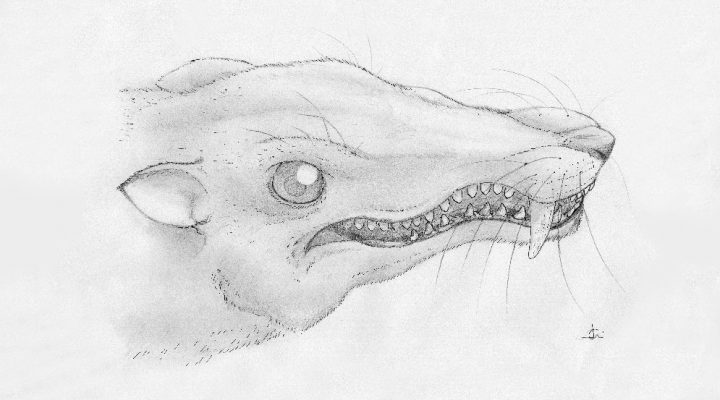EXACT AND NATURAL SCIENCES
Remains of a mammalian ancestor of 220 million years are found in Argentina
It is a cranium of a new cynodont species discovered by CONICET researchers in the Los Colorados Formation.
Probainognathia is a clade of cynodonts that includes mammals as their only living representatives. In Argentina, numerous probainognathians have been found in Carnian levels (early Late Triassic, approximately 237 to 227 million years ago) but only a single species from the Norian was known (approximately 227 to 208 million years ago). Globally, probainognathian fossils are very scarce in Norian outcrops, even when the record of the group is rich before and after this age.
A recent discovery by CONICET paleontologists together with colleagues from Germany published in Scientific Reports contributes to filling this gap. A fragmentary skull of a new small probainognathian was found in outcrops of the Los Colorados Formation in Talampaya National Park (La Rioja Province, Argentina). The new species, which lived approximately 220 million years ago, is dubbed Tessellatia bonapartei.
‘Tessellatia comes from the Latin word tessella, each one of the tiles composing a mosaic, in reference to the combination of basal and derived features recognized in this taxon. The second part of the name, bonapartei, is a tribute to Dr. José F. Bonaparte, who worked unrelentingly to broaden our knowledge of Mesozoic ecosystems and described the first cynodont remains from the Los Colorados Formation in 1971 and 1980’, explains Leandro Gaetano, CONICET researcher in the Instituto de Estudios Andinos “Don Pablo Groeber” (IDEAN, CONICET-UBA) and leading author of the paper.
It is worth mentioning that the Los Colorados Formation is well-known for its very important reptilian fossil assemblage. However, until now, only a few small cynodont fossils have been found. It is in this context that the authors of the study renovated the exploration efforts in this unit and, since 2014, they have worked in its paleontological and geological analysis, with very promising results.
Using top-end technology to study the fossil
Due to the fragility of the bones and the tiny size of the remains – the skull is approximately 3cm long –, removing the rock mechanically was almost impossible. In addition, the analysis of internal features of the specimen could not be done by traditional means. Hence, the researchers decided to study the new species through computed tomography (CT).
Initially, the more common technique of X-ray CT was employed. Although the obtained images were acceptable, they were not good enough. Thus, neutron CT studies were performed initially in Argentina (RA-6, CNEA) and then in Germany
(Antares Instrument of the Forschungs-Neutronenquelle Heinz Maier-Leibnitz of the Technical University of Munich).
‘The results were excellent. With neutron CT, still relatively rare in paleontology, it was possible to study in detail the anatomy of the skull, lower jaw, and dentition. Furthermore, structures otherwise unavailable could be analyzed, such as dental replacement and the path of certain cranial nerves in the snout, which suggests the presence of vibrissae’, points out Gaetano.
Peculiar features of Tessellatia and its complex phylogenetic placement
Teeth are one of the elements generally used to hypothesize the phylogenetic relationships among cynodonts. But, in this case, although the new taxon shows a dentition similar to more derived Triassic and Jurassic forms – suggesting a closer relationship with mammals – the length of the palate – shorter than expected – and the bones that constitute the orbit are similar to more primitive animals. ‘Features like these are those that make Tessellatia a mosaic and its classification problematic’, says Fernando Abdala, CONICET researcher in the Unidad Ejecutora Lillo (UEL, CONICET – FML) and second author of the paper.
With the aim of understanding the relationships of Tessellatia bonapartei, the Scientific Reports paper offers the most inclusive phylogenetic analysis of cynodonts performed to date regarding the number of taxa and characters considered.
Despite the new species being found to be relatively early-diverging and not very closely related to the first mammals, the researchers state that this is a provisional hypothesis. ‘It is a hypothesis based on our present knowledge. Phylogenies are always under construction. It is very possible that new information will modify the position of Tessellatia in the evolutionary tree’ says Abdala.
Finally, the authors performed the first quantitative biogeographic analysis for probainognathians to better understand the biogeographic history of the group. This study allowed us to recognize different biogeographic events such as diversifications and dispersions.
‘To study the biogeographic history of a group means tackling questions such as: where did the lineage originate? How did it disperse? How was it distributed? In which places and where did it become extinct? When analyzing the history of Probainognathia, it is clear that Gondwana – the continental mass that included today’s southern hemisphere continents – had a great importance in the origin of earliest clades of the group. Brazil, Argentina, and southern Africa were especially relevant during the Middle and early Late Triassic. Only after the second pulse of diversification, after the Norian, the northern hemisphere continents became relevant for the history of probainognathians’ states Federico Seoane, CONICET researcher in the IDEAN and also author of the study.
This study highlights the importance of Triassic strata in Argentina and South America in the record of early-diverging cynodonts to unravel the evolutionary history of the mammalian ancestors.
By Miguel Faigón
References:
Gaetano, L.C, Abdala, F., Seoane, F.D.,Tartaglione,A., Schulz, M., Otero, A., Leardi, J.M., Apaldetti, C., Krapovickas, V., and Steinbach, E. 2022. A new cynodont from the Upper Triassic Los Colorados Formation (Argentina, South America) reveals a novel paleobiogeographic context for mammalian ancestors. Scientific Reports. DOI: https://doi.org/10.1038/s41598-022-10486-4.
